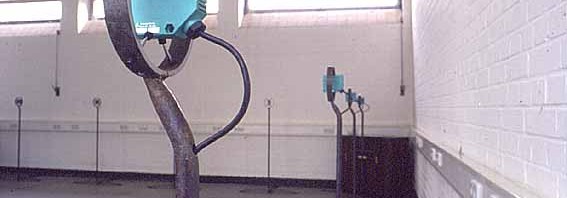Eight infra-red detectors are placed in two rows of four at right angles to one another as shown thus forming an invisible grid. The normally open contact on each detector switches five volts which, when closed through interruption of the beam, feeds a computer input (i,o) card. The computer, in turn, is equipped with a sound blaster card connected to speakers. Both computer and speakers are housed inside a 1950’s style Grundig radiogram. Interruption of one beam evokes no response. If, however, one beam from each row is simultaneously broken (e.g. coordinate B-3), then the signals from this combination trigger a computer response. Each coordinate contains excerpts selected from speeches recorded during the last 70 years. For example, B-3 = Ulrike Meinhoff, 1968. So when, for example, interruption of beams B&3 occurs, the voice of Ms. Meinhoff will speak one ‘paragraph block’ from this 1968 speech, then stop.
There will be no further activation of this coordinate until it is vacated, then re-entered – at which time the voice of Ms Meinhoff will continue on with the following ‘paragraph block’. If, as will often be the case, there is another coordinate activated before de-activation of B-3, then this other coordinate will release its corresponding ‘paragraph block’. Its activation will force the volume of the first triggered coordinate down, and if yet another is triggered this will also force down the volume of the second. In this way reward (by way of volume dominance) is given to mobility within the grid. Coordinates can also be triggered by the interruption of two single beams by two separate participants. This use of vectors encourages communal interaction. Up to four speeches can operate simultaneously. The theatrical presentation of the piece lacks only the performers, the design being to an extent self-explanatory, cueing participants into the general concept. In this piece unencumbered interactivity offers access which requires no preparation, and allows ease of negotiation for people with ‘technology inhibitions’.
Materials: sensors, 486 computer, steel, radio, cables
Dimensions: variable, 64 to 150 sqm


